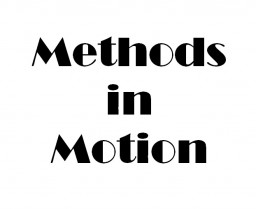
The key question to answer when thinking about method is ‘how do we know?’ But what has the idea of ‘being in motion’ got to do with knowledge and how we know it? In this blog I will take a big step back and examine how, in the history of natural science, ‘being in motion’ has put our knowledge into question. This, in my view, is interesting because it shows how questioning knowledge itself is a crucial part of understanding the effects of using different research methods, and is not a solely philosophical matter.
The troublesome notion of ‘being in motion’ has been a theme in science for hundreds of years, and it surely reached a zenith with Einsteinian relativity. It is no exaggeration to say that Einstein put all prior scientific certainty into question. Perhaps understandably, for most of human existence people have taken it for granted that we know when we are in motion and when we are standing still. Actually, making this simple distinction is remarkably troublesome. Galileo worked out that when we are standing on solid ground it might feel like we are standing still, but in fact we are zooming through space in an orbit around the sun. Being in motion, from Galileo’s time onwards, became a matter of perspective and not something that is absolute. A key issue then becomes: how to broaden your perspective?
From the perspective of a person standing on the earth, the earth feels still and the stars and planets appear to move around it. Building on previous centuries of research, Galileo constructed a perspective which put our sun at its centre. If the planets orbit the sun, then so does the earth, and so we earthlings must get our heads around the fact that our planet is hurtling through space at a speed approaching 67,000 miles per hour. But Galileo installed an important caveat: the motion of something is always relative to something else. 67,000 mph is therefore not an absolute speed, but a speed as judged from a perspective – a speed relative, in this case, to the sun. Something absolute is something certain because it is something that can serve as an unshakeable foundation for knowledge. Galileo’s core idea of relative motion does away with any such unshakeable foundation for establishing knowledge about motion. Motion is always relative and absolute motion makes no scientific sense.
Galileo’s motion relativism encourages us to recognise that everything is in motion, but that within this ‘everything’ there are sets of objects that move at the same velocity. As a result, some sets share certain features relative to other sets. A person sitting on a moving train, for example, is part of such a set that includes the train, the carriage, the seat, the table, the other passengers and so on. To this person their seat, the coffee cup on the table and the passenger opposite appear to stand (or sit) still, whilst the station platform outside rushes by at speed. For the person sat at the station platform, by contrast, their bench, the ticket office (and the other objects making up their set) stand still, whilst the train and its passengers rush by at speed. At the other end of the scale, the sun is not the stable centre of things, but itself orbits the centre of a galaxy that is racing away from other galaxies at colossal speeds. Motion only makes sense as the difference between sets. Neither can be said – in any absolute sense – to be the one truly in motion or the one truly at rest.
We see here how the concept of perspective becomes central to knowledge, but it was Einstein who broadened the perspective still further. Einstein made time itself a relative construct, much as Galileo had shown the relativity of motion. I won’t go into that here, but in a nutshell, Einstein showed that the spatial, the energetic and even the temporal characters of sets of objects vary with changes in their velocity relative to other such sets of objects. From this broadened perspective, motion is not movement in space over a unit of time, but the interval between events in a new, combined metric called ‘space-time’. In other words, it seems that movement does not only happen over (an amount of) time, it also has effects upon time.
Through describing the evolution of thought on movement, from Galileo to Einstein, I have tried to show that each advance in our knowledge simultaneously creates a new perspective that puts our prior knowledge into question. The theme of ‘being in motion’ therefore shows us that learning new knowledge is always also about learning what we don’t know. It is often more about broadening our sense of how much we still don’t know, rather than about securing the certainty of what we do. In fact, those who profess such certainty start to appear as suspiciously unscientific.
In my view, an emphasis on what we do not know, and a recognition of the importance of perspective extends also to the social sciences. I would go further and suggest that it is a vital point of transdisciplinary connection, between natural science, philosophy, social science and the arts and humanities. Around the time of Einstein, for example (and in critical engagement with his work), we see the mature emergence of the forms of process philosophy associated with Henri Bergson (in France), A.N. Whitehead (in the UK), and Ernst Cassirer (in Germany). In my field of social psychology, we have thinkers like G.H. Mead engaging with Bergson and Whitehead in an effort to grapple with the social science implications of Einsteinian relativity (including, indeed, the notion of ‘field’ that had become core to the physics of electro-magnetism and that was picked up by the Gestalt psychologists). Early qualitative methodologists in psychology like William Stephenson (who invented Q methodology) were engaging with the same heady mix. With the likes of Stephenson and Mead, we get a sociological psychology, and a psychological sociology which embeds the concept of subjective perspective at the very core of social scientific knowledge, and that understands all of nature (human nature included) as a field of incompletion in process of becoming.
Perhaps, inspired by Einstein’s theorisation of the fundamental relationship between movement, space and time, it is the moment for a re-evaluation of these historical figures, to further push forwards our understanding of the relationship between what we know and how we know it.
More on Methods in Motion
The Methods in Motion blogs are by researchers linked to the Centre for Citizenship, Identities and Governance. The blogs represent their opinions emerging from research in progress, and do not necessarily represent the views of the Research Centre or Open University. You can discover more about Methods in Motion on the CCIG website.






Rate and Review
Rate this article
Review this article
Log into OpenLearn to leave reviews and join in the conversation.
Article reviews